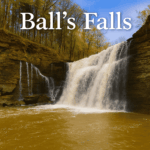Plan your visit during spring in Ontario to experience waterfalls like Balls Falls in full strength. The melting snow from winter creates powerful cascades, making this the optimal time to witness waterfalls at their peak flow. The lush landscape around Ontario enhances the vibrant atmosphere, creating perfect conditions for memorable photos and outdoor exploration.
From late March to early June, water levels remain high as snowpack gradually releases, feeding waterfalls across Canada. Balls Falls, in particular, reaches spectacular proportions during this period, drawing visitors who seek the most dramatic views. These months also offer comfortable weather, making outdoor activities more enjoyable.
Be aware that late spring and early summer bring the fullest waterfalls in Ontario. While summer months can still produce impressive flows, drier conditions tend to cause a reduction in volume. Planning your trip between March and June ensures you witness water cascading powerfully over rocks and cliffs, highlighting the raw energy of these natural features.
Timing and Climate Conditions for Peak Water Volume Throughout the Year
To experience Niagara Falls at its fullest flow, visit during the spring months from March to May, when melting snow and increased rainfall boost water levels. The area around Ontario receives more precipitation during this period, which significantly enhances water volume at popular waterfalls like Balls Falls.
Spring and Early Summer
Late March through early June marks the peak flow period. Increased rainfall combined with snowmelt from the surrounding region, including parts of Ontario and areas upstream of Niagara, results in the most impressive water display. During this time, waterfalls are at their most powerful, offering a spectacular view and the loudest roar.
Climate Conditions Affecting Water Flow
Rainfall plays the dominant role in maintaining high water levels at Niagara and Balls Falls. Heavy precipitation from late winter to early summer directly translates into fuller waterfalls. Conversely, prolonged dry spells or drought conditions reduce flow, making summer, especially July and August, less ideal for full-flow views despite warm weather.
Monitoring local weather patterns and recent rainfall data can help plan optimal visits. After heavy storms in late winter or early spring, water volumes tend to stay high for several weeks, providing opportunities for striking waterfall scenery.
Regional Rainfall Patterns That Lead to Thundering Waterfalls
Heavy and consistent rainfall in Ontario significantly boosts water flow in Balls Falls, making it the prime time to witness the waterfall at its fullest. These rains often occur during spring and early summer, driven by frontal systems that bring moisture from the Atlantic, saturating the region’s soil and rivers.
In Canada, especially around Ontario, moist air masses from the Gulf of Mexico influence rainfall patterns, contributing to frequent showers and thunderstorms from late spring through early fall. These weather systems pour large volumes of rain over the area, causing the waterfalls, such as Balls Falls, to roar with power and volume.
Impact of Seasonal Rainfall on Waterfall Flow
Increased rainfall within this period results in full-flow conditions at Balls Falls, transforming the landscape. The rivers swell, and the waterfalls deliver thunderous cascades that delight visitors seeking dramatic, full-flow views. Monitoring local weather reports helps predict when these rainfall patterns peak, ensuring optimal viewing moments.
Planning Your Visit During Seasonal Events and Weather Windows for Optimal Viewing
Visit Ontario and Canada during late spring and early summer, typically from May to June, to experience waterfalls like Balls Falls at their peak flow. During this period, increased snowmelt and spring rains significantly boost water volume, creating spectacular cascades and thunderous sounds. Check local weather forecasts for warm, rainy days, as these conditions augment waterfall flow without risking excessive flooding.
Timing your trip around specific seasonal events enhances your viewing experience. Look for annual festivals or community celebrations near Balls Falls, often scheduled in late spring or early summer, which coincide with high water levels. Planning visits during these events allows for a vibrant atmosphere alongside nature’s display.
Weather Windows for Best Viewing
After heavy rainfall within a 24-48 hour window, waterfalls display their fullest flow. Keep an eye on local weather reports indicating recent and forecasted rainfalls. Avoid periods of drought or extended dry spells, as they reduce water volume and diminish the visual impact of waterfalls.
Early mornings following a rainy night and overcast days often provide softer lighting and fewer crowds, offering an ideal setting for photography and peaceful observation. During early summer, extended daylight hours also mean longer viewing times, giving you flexibility to choose the optimal moment for your visit near Balls Falls or other Ontario waterfalls.
By aligning your trip with regional weather patterns and seasonal festivities, you maximize the chance to enjoy waterfalls at their fullest. Regularly consult local parks’ websites and weather services to refine your plans and ensure an unforgettable experience.

